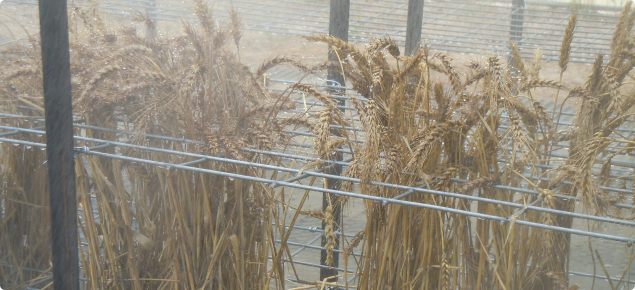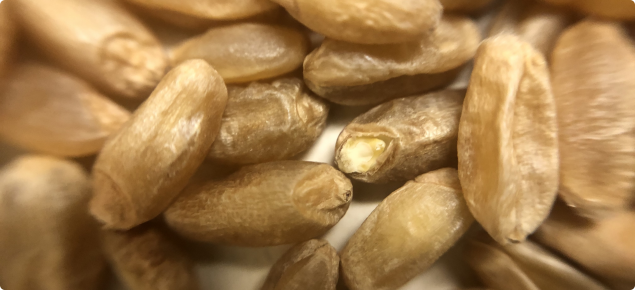A minimum falling number of 300 is required for delivery into most receival grades. There are several causes of low falling number in wheat and varieties differ in their propensity to exhibit low falling number. New wheat varieties are assessed against industry standards under a range of conditions that induce low falling number and are given a Falling Number Index (FNI) rating that represents their risk of exhibiting low falling number. A high FNI rating represents a lower risk of exhibiting low FN.
Falling number ratings for wheat
| Variety | Grade | FNI Rating |
|---|---|---|
| Bremer | AH | 5 |
| Calingiri | ANW | 4 |
| Catapult | AH | 6 |
| Chief CL Plus | APW (N) | 4 |
| Corack | APW | 4 |
| Cutlass | APW (N) | 4 |
| Devil | AH (N) | 3 |
| DS Pascal | APW | 7 |
| Emu Rock | AH | 2 |
| Hydra | APW | 3 |
| Illabo | AH | 5 |
| Impress CL Plus | APW | 2 |
| Kinsei | ANW | 4 |
| LRPB Cobra | AH | 2 |
| LRPB Havoc | AH (N) | 3 |
| LRPB Trojan | APW (N) | 5 |
| Mace | AH (N) | 5 |
| Magenta | APW | 3 |
| Ninja | ANW | 4 |
| Razor CL Plus | ASW | 4p |
| RockStar | AH (N) | 2 |
| Scepter | AH | 5 |
| Sheriff CL Plus | APW (N) | 4 |
| Supreme | ANW | 4 |
| Tungsten | AH | 3 |
| Vixen | AH (N) | 3 |
| Westonia | APW (N) | 2 |
| Wyalkatchem | APW (N) | 3 |
| Yitpi | AH | 5 |
| Zen | ANW | 3 |
| *p - provisional rating based upon a single year of data. | ||
What is the Falling Number Index?
Since 2013, wheat agronomy researchers at DPIRD have assigned a falling number index (FNI) that rates varieties for their ability to maintain falling number. The falling number of a grain sample is influenced by the variety being grown and how it responds to environmental conditions during growth and maturation, as well as environmental conditions it is exposed to following maturation. A falling number of less than 300 results in quality downgrades at receival, and so the falling number index is designed to guide growers to the relative differences between varieties for risk of low falling number.
The Falling Number Index uses a combination of data from the field, laboratory and through artificially induced (rainfall simulator) sprouting to determine the risk of a variety exhibiting low falling number. On a 1-9 scale, the higher the rating the more likely a variety is to maintain FN.
Why is falling number important?
Pre-harvest sprouting occurs when germination is induced within grains prior to harvest, usually in response to exposure to rainfall. This germination process induces the synthesis of enzymes (such as alpha-amylase) that begin to metabolise starch to fuel seedling growth, reducing the quality of the grain sample for its end use, e.g. for baking. The falling number test is a preferred method of testing for pre-harvest sprouting damage, as only a relatively small increase in alpha-amylase is required to reduce quality and this can occur in grain samples with minimal visual signs of sprouting. The test measures the viscosity of a flour-water mixture, with grain containing elevated alpha-amylase levels producing a mixture with lower viscosity and a lower falling number. While there are other causes of reduced falling number besides pre-harvest sprouting, these are not easily distinguishable, and so all samples detected with low falling number are downgraded.
What influences the susceptibility of a crop to low falling number?
The likelihood of a crop exhibiting low falling number is the result of complex interactions between the genetics of the variety, the environmental conditions it is exposed to, and at what growth stages these environmental conditions occur.
Variety
Varieties differ in their susceptibility to low falling number due to a number of factors;
- Varieties differ in their levels of grain dormancy; grains of a highly dormant variety will forgo germination even under favourable conditions until this dormancy wears off (days to months later). This trait is a primary focus of breeders and researchers in developing sprouting resistant varieties. Most of the varieties currently grown in WA usually exhibit only low levels of grain dormancy and as a result, their dormancy generally doesn’t correlate strongly with their expression of pre-harvest sprouting in the field.
- The physical attributes of the head and grain (e.g. ear waxiness, absence of awns, tight glumes) as well as physiological factors (e.g. presence of black point staining) may increase or decrease PHS susceptibility, particularly in varieties with minimal grain dormancy.
- There are other known causes of low falling number in wheat besides PHS, such as late-maturity alpha-amylase (LMA), and varieties differ significantly with regards to their susceptibility to the incidence of LMA.
Environment
There are a number of environmental conditions that can directly induce low falling number or increase susceptibility to future weather events;
- Rainfall is the key contributor to increased pre-harvest sprouting incidence. The nature, frequency and duration of rainfall events and the associated weather conditions can all impact the level of PHS that will occur in a mature or maturing crop, although conditions that promote a long duration of elevated grain moisture will generally have the greatest impact.
- Certain grain characteristics can be influenced by environmental conditions during important stages in grain filling and this may increase or decrease susceptibility to later weather events. For example, temperature and drought stress during grain filling can alter the expression of grain dormancy, while rainfall in the lead-up to maturation that does not directly induce sprouting can increase the susceptibility of the grain to sprouting during later rainfall events.
- Falling number in the absence of sprouting can vary significantly. In extreme cases, conditions that cause expression of late maturity alpha-amylase (LMA) can reduce falling number below receival standards even in the absence of rainfall.
Crop maturation stage
The susceptibility of any given wheat variety to environmental conditions that will cause low falling number is not fixed, but rather changes with maturation stage;
- Grain dormancy is a trait that wears off over time, so a crop is exposed to rainfall after a significantly prolonged period after maturation is more likely to exhibit pre-harvest sprouting.
- Grain dormancy is influenced by growth conditions, and so a different season or location can induce increased or reduced grain dormancy.
- Rainfall in the lead-up to physiological maturity has been shown to predispose crops to future PHS damage, or can directly cause pre-harvest sprouting even before the crop has reached maturity.
Managing the risk of low falling number
The likelihood of a crop exhibiting low falling number is the result of complex interactions between the genetics of the variety, the environmental conditions it is exposed to, and at what growth stages these environmental conditions occur.
While in many seasons incidences of low falling number may be rare across a range of varieties, in other years seasonal conditions (particularly prevalent harvest rainfall) may occur that are conducive to pre-harvest sprouting and low falling number. Varieties with a higher Falling Number Index are less likely to exhibit low falling number in these seasons, and hence, can reduce risk of quality downgrades at receival.
Aside from managing exposure to risk through varietal choice, reducing exposure to rainfall events is also key, and so timely harvesting is especially important to reduce the exposure of crops to rainfall events that may reduce falling number.
Recent research from Western Australia has highlighted the importance of optimising variety choice with sowing date, not just for yield, but to also manage the risk of pre-harvest sprouting. Crops that mature earlier in spring (coinciding with generally wetter and cooler conditions) exhibit an elevated risk of pre-harvest sprouting. When managing PHS, growers should understand that earlier maturation (through early sowing and maturity types) is likely to increase their risk of downgrades due to PHS and when sowing early, growers should target slower maturing varieties with increased PHS resistance (a higher Falling Number Index). For more information, view the attached 2022 Research Updates paper, Pre-harvest sprouting management begins at seeding.
Acknowledgments
Research staff acknowledge the breeding companies for their support in this research.
Kevin Young (GxE Crop Research) provided leadership in the development of the protocols used in evaluating varieties for their FN Index.
This research has been comducted through funding from DPIRD (2013-present) and from the Grains Research and Development Corporation (2013-2019).


